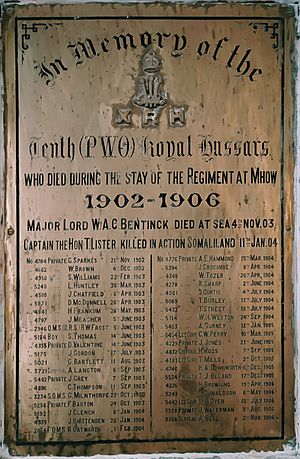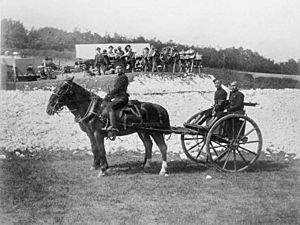10th Royal Hussars facts for kids
Quick facts for kids 10th Royal Hussars (Prince of Wales's Own) |
|
|---|---|

Badge of the 10th Royal Hussars
|
|
| Active | 1715–1969 |
| Country | |
| Branch | |
| Type | Cavalry |
| Role | Line cavalry |
| Size | 1 Regiment |
| Nickname(s) | Baker's Light Bobs, The Chainy 10th, The Shiny 10th |
| Motto(s) | Ich Dien (I Serve) |
| March | (Quick) The Merry Month Of May |
| Anniversaries | El Alamein (23 Oct) |
| Commanders | |
| Notable commanders |
John Vaughan Reginald Barnes |
The 10th Royal Hussars (Prince of Wales's Own) was a special cavalry regiment in the British Army. It was started in 1715. A cavalry regiment is a group of soldiers who traditionally fought on horseback. This regiment served for nearly 300 years. They fought in big wars like the First World War and the Second World War. In October 1969, the 10th Hussars joined with the 11th Hussars (Prince Albert's Own). Together, they formed a new group called the Royal Hussars (Prince of Wales's Own).
Contents
History of the 10th Royal Hussars
Early Days of the Regiment
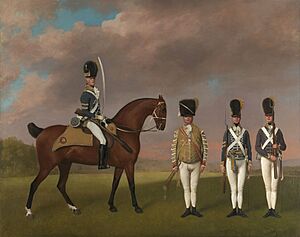
The regiment began in 1715 in a town called Hertford. It was first known as Gore's Regiment of Dragoons. Dragoons were soldiers who could fight on horseback or on foot. This group was one of 16 new regiments created to stop the Jacobite uprising of 1715. The uprising ended before the regiment was ready to fight. Most of these new groups were closed down by 1718. But Gore's Regiment stayed active.
For the next 25 years, they mostly worked as garrison duty. This means they were stationed in places to protect them. They were mainly in the West Country of England. Their first real battles were during the 1745 uprising. They fought at the Battle of Falkirk Muir in January 1746. Then they fought at the Battle of Culloden in April. In 1751, the regiment was renamed the 10th Regiment of Dragoons. This was part of changes made by the Duke of Cumberland.
Fighting in Europe: Seven Years' War
From 1756 to 1763, the regiment took part in the Seven Years' War. In June 1758, they were part of a Raid on St Malo in France. They then fought in several big battles. These included the Battle of Minden in August 1759. They also fought at Warburg in July 1760. In October, they were at the Battle of Kloster Kampen. Their commanding officer, Colonel William Pitt, was badly hurt and captured there.
The regiment also helped the Allies win at the Battle of Villinghausen in July 1761. This victory made the French army go on the defensive. It eventually led to the Treaty of Paris in 1763, which ended the war.
In 1779, a small part of the regiment left to form a new group. In 1783, the regiment was honored. It became the 10th (Prince of Wales's Own) Regiment of (Light) Dragoons. This was to honor the future King George IV. Because of this connection, the regiment became famous for its fancy and expensive uniforms. Officers needed to be quite rich to join. In 1794, Beau Brummell, a famous fashion leader, joined as a cornet. He left in 1795 when the regiment moved from London.
Napoleonic Wars: Battles in Spain
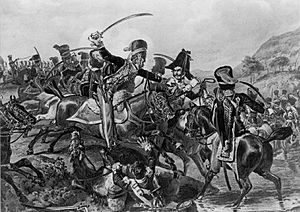
In 1806, the regiment changed its name again. It became a hussar regiment. Hussars were a type of light cavalry known for their distinctive uniforms. They were called the 10th (Prince of Wales's Own) Regiment of (Light) Dragoons (Hussars). In November 1808, they sailed to Spain.
They fought in the Peninsular War. This included the Battle of Sahagún in December 1808. They also fought at the Battle of Benavente later that month. At Benavente, the regiment captured General Charles Lefebvre-Desnouettes. He was the French cavalry commander. The regiment then took part in the Battle of Corunna in January 1809. After that, they went back to England.
In 1813, they returned to Spain. The regiment fought at the Battle of Morales in June 1813. During this battle, they defeated the 16th French Dragoons. They captured about 260 enemy soldiers. The regiment also fought at the Battle of Vitoria later that month. They then moved into France. They fought at the Battle of Orthez in February 1814. Their last battle in this war was the Battle of Toulouse in April 1814. As part of the 6th Cavalry Brigade, the regiment charged French soldiers at the famous Battle of Waterloo in June 1815.
Victorian Era Battles

In 1846, the regiment was sent to India. They later saw action during the Crimean War. This included the Siege of Sevastopol in the winter of 1854. They also fought at the Battle of Eupatoria in February 1855. In 1861, their name changed again to the 10th (The Prince of Wales's Own) Royal Hussars.
The regiment fought at the Battle of Ali Masjid in November 1878. This was during the Second Anglo-Afghan War. They also fought at the First and Second Battles of El Teb in February 1884. This was during the Mahdist War.
When the Second Boer War started, the regiment sailed to South Africa in November 1899. They fought at Colesberg. Then, they helped relieve the siege of Kimberley in February 1900. They were also involved in the Battle of Diamond Hill in June 1900. After the war ended in 1902, they went to India. Many officers and men traveled from Cape Town to Bombay. They were then stationed at Mhow. The regiment was next involved in action on the North-West Frontier in 1909.
The First World War
At the start of the First World War, the regiment was in Potchefstroom, South Africa. They returned to the UK. In October 1914, they landed at Ostend in Belgium. They were part of the 6th Cavalry Brigade. This brigade was in the 3rd Cavalry Division. They joined the British Expeditionary Force on the Western Front.
Between the World Wars
After the First World War, the regiment served briefly in Ireland. On June 22, 1921, they provided a royal escort for King George V. He was opening the first Parliament of Northern Ireland. Two days later, their train was attacked. Twenty-four hussars and eighty of their horses were killed or hurt.
The regiment returned to the UK in 1921. It was renamed the 10th Royal Hussars (Prince of Wales's Own). They went to Egypt in 1929 and India in 1930. In 1936, they came back to the UK. Here, they started to become "mechanized." This meant they began to use tanks and armored vehicles instead of horses. In 1939, they joined the 2nd Armoured Brigade. This brigade was part of the 1st Armoured Division. At the same time, they became part of the Royal Armoured Corps.
The Second World War
When the Second World War began, the 1st Armoured Division went to France. They fought in northern France and Belgium. In June 1940, they returned to England without any vehicles. In December 1940, some soldiers left to help form a new regiment, the 23rd Hussars.
In November 1941, the regiment went to North Africa. They joined the 7th Armoured Division. They now had Crusader tanks. They fought in Operation Crusader. They also fought at the Battle of Alam el Halfa in August 1942. In October 1942, they were at the Second Battle of El Alamein. At El Alamein, the regiment captured General Wilhelm Ritter von Thoma. He was the German Deputy Commander. The regiment then fought in the Italian Campaign in 1944 and 1945. They fought both as an armored unit and as soldiers fighting on foot.
After the Wars
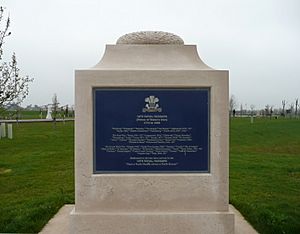
In 1946, the regiment was sent to Lübeck in Germany. They were an armored regiment in the British Army of the Rhine. In 1948, they moved to Epsom Barracks in Iserlohn. They returned to the UK in July 1953. In February 1956, they went to Aqaba in Jordan. They helped the Jordanian Government there. Sadly, 19 members of the regiment died in a plane crash in April 1957.
After returning to the UK in July 1957, they moved to Swinton Barracks in Munster in July 1959. Then they moved to Barker Barracks in Paderborn in June 1960. They came home again in March 1964. In August 1964, they went to Aden during the Aden Emergency. The regiment moved to York Barracks in Munster in September 1965. After coming home in September 1969, they joined with the 11th Hussars (Prince Albert's Own). This formed the Royal Hussars (Prince of Wales's Own) in October 1969.
What They Wore: Uniforms
The regiment first wore red dragoon coats. These had "deep yellow" facings (colored parts on the uniform). In 1784, they started wearing dark blue uniforms. They also had a special crested helmet. They began to adopt hussar dress over time. This included a busby (a tall fur hat) in 1809.
Until 1914, the whole regiment wore dark blue hussar uniforms for full dress. They had a red busby bag and yellow braiding. They also had a white plume and yellow stripes on their riding breeches. Officers had a unique criss-crossed metal decoration on their pouch-belts. This gave the regiment its nickname, "The Chainy 10th."
Their Music Band
The regiment's band started as early as 1786. In the 1850s, the band served with the regiment in India and Afghanistan. In December 1911, King George V visited India. The regiment's trumpeters were allowed to wear royal livery (special uniforms). When the regiment moved to Bloemfontein, the band became very popular.
The band also went with the regiment in India during the 1920s and 30s. It was one of the first bands to visit troops in France after the D-Day landings. The band then served with the hussars in West Germany during the Cold War. In 1961, the band had its last parade. This was with the last Drum Horse of the 10th Royal Hussars. When the regiment returned to Tidworth in 1969, it joined the 11th Hussars. The two regimental bands also merged to form The Royal Hussars band.
Brave Soldiers: Victoria Crosses
Two members of the regiment earned the Victoria Cross. This is the highest award for bravery in the British military.
- Sergeant Henry William Engleheart - earned in the Second Boer War, March 13, 1900
- Lieutenant Sir John Milbanke, 10th Baronet - earned in the Second Boer War, January 5, 1900
Where to Learn More
The collection of the regiment is kept at HorsePower: The Museum of the King's Royal Hussars. This museum is located at Peninsula Barracks in Winchester.
Important Battles They Fought
The regiment was honored for fighting in many important battles. These are called "battle honors."
- Early wars: Warburg, Peninsula, Waterloo, Sevastopol, Ali Masjid, Afghanistan 1878–79, Egypt 1884, Relief of Kimberley, Paardeberg, South Africa 1899-1902
- The Great War: Ypres 1914 '15, Langemarck 1914, Gheluvelt, Nonne Bosschen, Frezenberg, Loos, Arras 1917 '18, Scarpe 1917, Somme 1918, St. Quentin, Avre, Amiens, Drocourt-Quéant, Hindenburg Line, Beaurevoir, Cambrai 1918, Pursuit to Mons, France and Flanders 1914-18
- The Second World War: Somme 1940, North-West Europe 1940, Saunnu, Gazala, Bir el Aslagh, Alam el Halfa, El Alamein, El Hamma, El Kourzia, Djebel Kournine, Tunis, North Africa 1942–43, Coriano, Santarcangelo, Cosina Canal Crossing, Senio Pocket, Cesena, Valli di Commacchio, Argenta Gap, Italy 1944-45
Images for kids



